




TaxiPoint Chief Editor:
Perry Richardson
TaxiPoint Publishing & Advertising Manager:
Lindsey Richardson
Visit us online at:
www.taxi-point.co.uk
Write to us at:
contact@taxi-point.co.uk
Advertising enquiries at: advertising@taxi-point.co.uk






TaxiPoint Chief Editor:
Perry Richardson
TaxiPoint Publishing & Advertising Manager:
Lindsey Richardson
Visit us online at:
www.taxi-point.co.uk
Write to us at:
contact@taxi-point.co.uk
Advertising enquiries at: advertising@taxi-point.co.uk

The publishers reserve the right to refuse, withdraw, amend or otherwise deal with all advertisements without explanation. All advertisers must comply with the British Code of Advertising practice.
The views expressed in this publication are not necessarily those of the publishers.
All written and image rights are reserved by the author as displayed. Reproduction in whole or in part without prior permission from the publisher is strictly prohibited.
Copyright brand TaxiPoint 2024. Creative Common image licences displayed where applicable.


Hello and welcome to the latest edition of TaxiPoint Magazine.
First up, thank you to everyone that took part in the first-ever National Taxi and Private Hire Driver Survey. The survey has now closed and our partners at TaxiPlus are unpacking the data into the first report of its kind.
A massive shoutout to TaxiPlus who have been excellent throughout the process and all the survey participants who took ten minutes of their time to hopefully deliver a very important document moving forwards that covers all aspects of the industry. The results should be available mid-November.
We’d also just like to take the opportunity to thank you and everyone else that’s pushing TaxiPoint on to new levels within the industry. Over the last 12 months over 230,000 return users have accessed TaxiPoint for all the latest taxi news. On a wider scale, over 1.3m reader have visited the TaxiPoint website in total over the same time period.
Thank you to all the readers, advertisers and network of people that contribute to the ecosystem that allows us to keep the trade informed and connected like never before.
Be lucky,

TaxiPoint Editor and Founder



There’s long been a misconception from those outside the trade that the taxi industry in the UK operates like a cartel, controlling prices and limiting competition. Critics outside the industry sometimes label it as such, but a closer look reveals this argument to be misguided. The taxi trade is a regulated service, but it is far from the closed-off, price-fixing entity that a cartel represents.
To understand this debate, we must first define what a cartel truly is. A cartel is an agreement between competing businesses to fix prices, limit production, or restrict new entrants in order to maintain control over a market. It is an illegal practice because it stifles competition and is harmful to consumers, inflating prices and reducing choice. By contrast, the taxi industry operates within a framework of regulation designed to protect consumers and maintain service standards, not to
limit competition or manipulate the market.
Becoming a taxi driver in the UK is an accessible process for anyone who meets the necessary criteria. The licensing process is straightforward and nondiscriminatory. Like any profession where public safety is involved, there are standards that must be adhered to. For example, applicants must pass criminal record checks, topographical tests, and medical assessments.


These requirements are not barriers designed to keep people out of the trade but safeguards that ensure drivers are fit for purpose.
To say that the taxi industry is a cartel because it sets standards for drivers would be the same as accusing other regulated industries of the same. Take the gas-fitting industry, for example. Could any company legally start installing boilers without meeting the safety standards and certification required? Or what about medicine? Could anyone set up as a medical practitioner without the necessary qualifications and regulation? The answer is no, and rightly so. These rules are in place to protect the public, not to artificially restrict entry or limit competition.
When it comes to pricing, the taxi trade is also often misunderstood.
The fares set by taxi meters are maximum prices, not fixed prices. Drivers have the flexibility to charge less if they choose to. This is a crucial distinction. While it is true that local authorities set fare caps, these are in place to protect consumers from being overcharged. Private hire vehicles (PHVs), meanwhile, can set their prices independently. Far from price-fixing, this structure allows for flexibility while still safeguarding passengers from excessive fares.
The regulated fare structure is in place for the same reason that other public services like buses, trains, and even NHS dental care have price caps – to prevent the public from being unfairly charged for essential services. Removing these protections would likely lead to unchecked price increases, as seen in industries where
regulation is less stringent. Without price controls, services that are critical to daily life could become unaffordable for many.
The suggestion that the taxi industry functions as a cartel doesn’t stand up to scrutiny. The reality is that it operates within a regulated framework designed to ensure public safety, fair pricing, and accessibility for drivers and passengers alike. Far from restricting competition, the licensing process allows anyone who meets the necessary criteria to become a cabbie. And with fare flexibility built into the system, accusations of price-fixing fall flat.
In essence, the taxi industry in the UK is a public service with consumer protections built in –not the closed-off cartel some would argue.

TaxiPoint recently posed an interesting question to its readers: would passengers change their minds if they were told the taxi or private hire vehicle (PHV) arriving to pick them up was not licensed in the area? The question prompted over 150 mixed responses from drivers, but a clear theme emerged – most think passengers don’t care.
Jason Kauder observed that Uber and its drivers, operating across multiple licensing authorities, are doing well. Carl Hoar echoed this, saying, “Doubt if the punters care”. Similarly, Imran Hussain and Kenneth Keenaghan agreed that passengers simply want a convenient ride, often with price being their main concern.
However, some drivers felt passengers might be more concerned than we think. Scott Jardine has noticed passengers questioning why vehicles from Wolverhampton, Bury, or Oldham are operating in Liverpool, and said some now prefer local Hackney cabs at night, potentially due to safety concerns. So, do passengers care? According to most drivers, no. But some, like Scott, believe
awareness of non-locally licensed cars picking them up is growing.
This brings us to the rules surrounding cross border taxi operations. In England, taxi and PHV drivers must be licensed, but they are often able to pick up fares outside the council area that issued their licence. This has become a contentious issue, particularly in larger cities, as drivers from other regions flood the streets, leading to concerns over safety and enforcement.
Lichfield District Council has proposed a policy to address this. Their plan requires operators to inform passengers when an out-of-area driver or vehicle will be used for their journey. This could provide greater transparency and allow passengers to make more informed choices.
But the real question remains: will this policy actually change behaviour? If the feedback from TaxiPoint readers is anything to go by, it’s unlikely to have a major impact. Most passengers just want to get from A to B without worrying about licensing boundaries. For now, the debate continues.





The rapid rise in private hire vehicles (PHVs) across UK roads has become a growing concern, prompting repeated calls for regulatory changes from regions most hit. With an increasing number of PHVs, particularly driven by the popularity of ridesharing apps, there has long been mounting pressure on governments, past and present, to consider a cap. Despite ongoing debate, the legal
Paul Elliott, representing the Department for Transport (DfT), recently spoke on this matter, shedding light on the complexities involved. He clarified that licensing authorities in England currently do not have the power to impose limits on the number of PHV licences they issue. This restriction has left many industry figures and local councils frustrated, as they are unable to respond to the surge in PHVs, which continues to affect
hackney carriage licences issued, provided they can demonstrate there is no significant unmet demand. This power, however, is rarely exercised, despite its availability under hackney carriage legislation. The DfT argues that caps on PHVs could lead to reduced availability and longer waiting times for passengers, suggesting that restrictions may not be in the public’s best interest.
One of the key distinctions


hailed on the street or found at designated ranks, whereas PHVs must be pre-booked via licensed operators. Under the existing Roads Traffic Act 1985, licensing authorities are permitted to restrict the number of hackney carriages operating in their area, but there is no equivalent provision for PHVs.
Section 16 of the Act provides the legal framework for limiting hackney carriage numbers, stating that a licence can only be refused if authorities are satisfied that no significant unmet demand exists in the area. This allows for a controlled balance between supply and demand for taxis, helping to ensure that oversaturation does not occur. However, with no such framework in place for PHVs,
their numbers have been growing steadily, exacerbated by the rise of app-based ride-hailing services like Uber.
The unchecked growth of PHVs has led to various challenges. Traditional taxi drivers face increased competition and falling demand for their services, as more passengers turn to appbased options. Additionally, concerns about congestion and environmental impact have been raised, as urban areas struggle to accommodate the increasing number of vehicles. Many argue that limiting PHV licences would help ease these issues and create a more level playing field for taxi drivers, while reducing the strain on local infrastructure.
Despite the growing calls for reform, the Government has so

far remained quiet over any potential future changes. The DfT has maintained its position that imposing caps on PHVs could harm passengers by reducing the availability of affordable and convenient transport options.
The question remains whether this new government may finally take action. Industry representatives and taxi drivers are hopeful that new leadership could lead to a shift in policy, allowing authorities to better regulate the number of PHVs on the road. However, with the legal framework deeply entrenched and concerns over the potential impact on passengers, any significant change seems far from certain.




cab was stationary, waiting to turn left from Kensington Church Street onto Kensington High Street. Dashcam footage shows a red doubledecker bus clipping the taxi, causing damage to the
help, a second bus from the same company struck the cab again. This time, the impact damaged further body panels and partially tore off the front bumper.

The second bus driver, cautious of worsening the damage, refused to move the double-decker, effectively blocking the junction. Armed police, already stationed nearby due to their presence at the Israeli Embassy, were called to the scene. The officers instructed the bus driver to reposition, allowing traffic to move again. A Transport for London (TfL) official was also summoned and concurred with the police's instructions.
The cab, after eight weeks of repairs, is now
back on the streets of the capital. The taxi driver who has been working in the industry since 2009, said: “I’ve never been involved in a crash in the near fifteen years I’ve been a taxi driver. To then be hit by two buses, in two separate incidents, on the same day is just ridiculous luck.
“The whole day just moved from one farce to another. Never did I think I’d be dealing with armed police and two bus crashes that shift!”
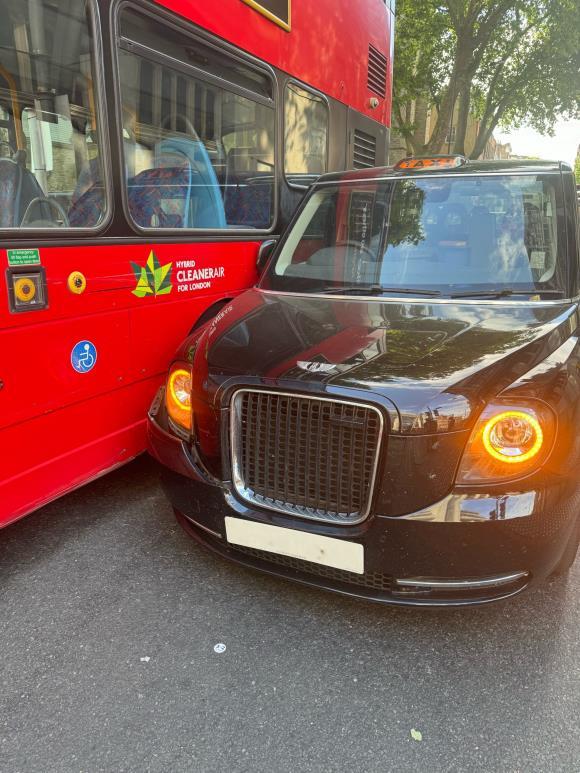





Dashcams and CCTV ‘provide solid evidence’ to help protect taxi drivers from losing their licence as crash for cash scams targeting taxi drivers surface.
A recent incident on Euston Road, London, highlights the rising threat of ‘crash for cash’ scams. A London
cabbie captured dashcam footage of a man deliberately throwing himself onto the bonnet of the vehicle, seemingly attempting to stage a fraudulent accident.
The dashcam footage shows the black cab moving slowly in traffic when a man, standing by the central reservation, suddenly steps out and flings himself onto the taxi. The man lies motionless on the road, arms raised, apparently faking injury, as the taxi halts immediately.

This type of scam, known as ‘crash for involves fraudsters fabricating collisions to make false injury and damage claims against drivers. Taxis and private hire vehicles are often targeted, as scammers believe they insured. Drivers in high-traffic areas are especially vulnerable, with congested roads providing a prime setting for these staged incidents.
However, the increasing use of dashcams and CCTV is providing essential protection for drivers against such fraudulent claims. The video evidence captured can disprove false accounts, safeguarding drivers from


legal penalties and the risk of losing their licence.
A spokesperson from ACSS, a provider of dashcams and CCTV for taxis, confirmed the scale of the issue: “Crash for cash scams have become a serious problem, with the Insurance Fraud Bureau reporting £1.7 million worth of claims related to these incidents. Installing CCTV or dashcams can play a crucial role in protecting drivers from being caught up in these scams.
“CCTV footage provides solid evidence, helping prove that the driver wasn’t at fault. This not only saves insurance companies from having to pay out false claims, but more importantly, it protects drivers
from losing their license or being penalised for dangerous driving. By having clear footage of the incident, drivers can avoid unjust penalties and protect their livelihood.
“In cases like these, having CCTV or dashcam footage can make all the difference, offering peace of mind and quick resolution of fraudulent claims.”

“In cases like these, having CCTV or dashcam footage can make all the difference…”



Generation Z, born into the age of smartphones and digital services, have grown up expecting convenience and transparency. This generation has been drawn to ride-hailing services such as Uber and Bolt, which offer glossy modern marketing, upfront pricing, and a booking process through their mobile device. For many youngsters, traditional taxis are seen as an outdated alternative, largely due to their perceived reliance on street-hailing or phone bookings, and fare structures that can feel unclear and unpredictable.
While cost is a driving factor for Gen Z when choosing transport, their preferences evolve as they move through life stages. As
incomes increase and responsibilities grow, concerns about comfort, safety, and reliability become just as important as price. This has long presented an opportunity for the traditional taxi industry to reposition itself to appeal more directly to what was once their younger audience.
For taxis to gain ground with Generation Z, digital integration is essential. Ride-hailing apps like Uber have set the standard, offering a streamlined user experience that makes booking a ride, tracking the vehicle, and paying for the journey fast and efficient. Traditional taxis have followed suit and, in some
markets, even lead by adopting similar technology.
Many local taxi firms have already begun to introduce their own apps, allowing passengers to book and pay through their phones, but with much lower marketing spend it is difficult reaching Gen Z.


Taxi apps need to match the level of user experience provided by their high budget ride-hailing competitors. This includes features such as real-time tracking, instant fare quotes, and options for digital payments. Without these modern conveniences, traditional taxis will struggle to compete for the attention of tech-savvy young travellers.
One of the reasons younger generations have gravitated towards ride-hailing apps is the transparency they offer around pricing. Passengers know the cost of their journey upfront, which removes the uncertainty associated with metered taxis. Traditional taxis could bridge this gap by implementing more transparent pricing systems, such as fixed rates for common routes or fare estimates provided through their apps.
While the metered system has long been a hallmark of the taxi industry,
younger customers value the ability to plan their budgets and avoid surprises. By offering clearer and more predictable pricing structures, taxis could become a more attractive option for those who prioritise cost certainty over saving every possible penny.
That said, a regulated meter offers security against surge charging models and is often over-looked.
Sustainability is a key concern for Generation Z. This group is more environmentally aware than previous generations, and their purchasing decisions often reflect a desire to support eco-friendly businesses. Ride-hailing services have recognised this trend, with some offering electric vehicle options or promoting their sustainability efforts. Traditional taxis can take advantage
of this by expanding their use of hybrid and electric vehicles, positioning themselves as a greener alternative. In London, the move towards electrifying the black cab fleet is already underway, but more could be done across the UK. Highlighting the environmental benefits of choosing a taxi, particularly when compared to older, petrolpowered vehicles used by some ride-hailing services, could help win over eco-conscious Gen Z passengers.
While cost and convenience are important, safety is a top priority for young people, particularly those travelling alone or late at night. Traditional taxis have long been subject to strict regulations around driver vetting, vehicle

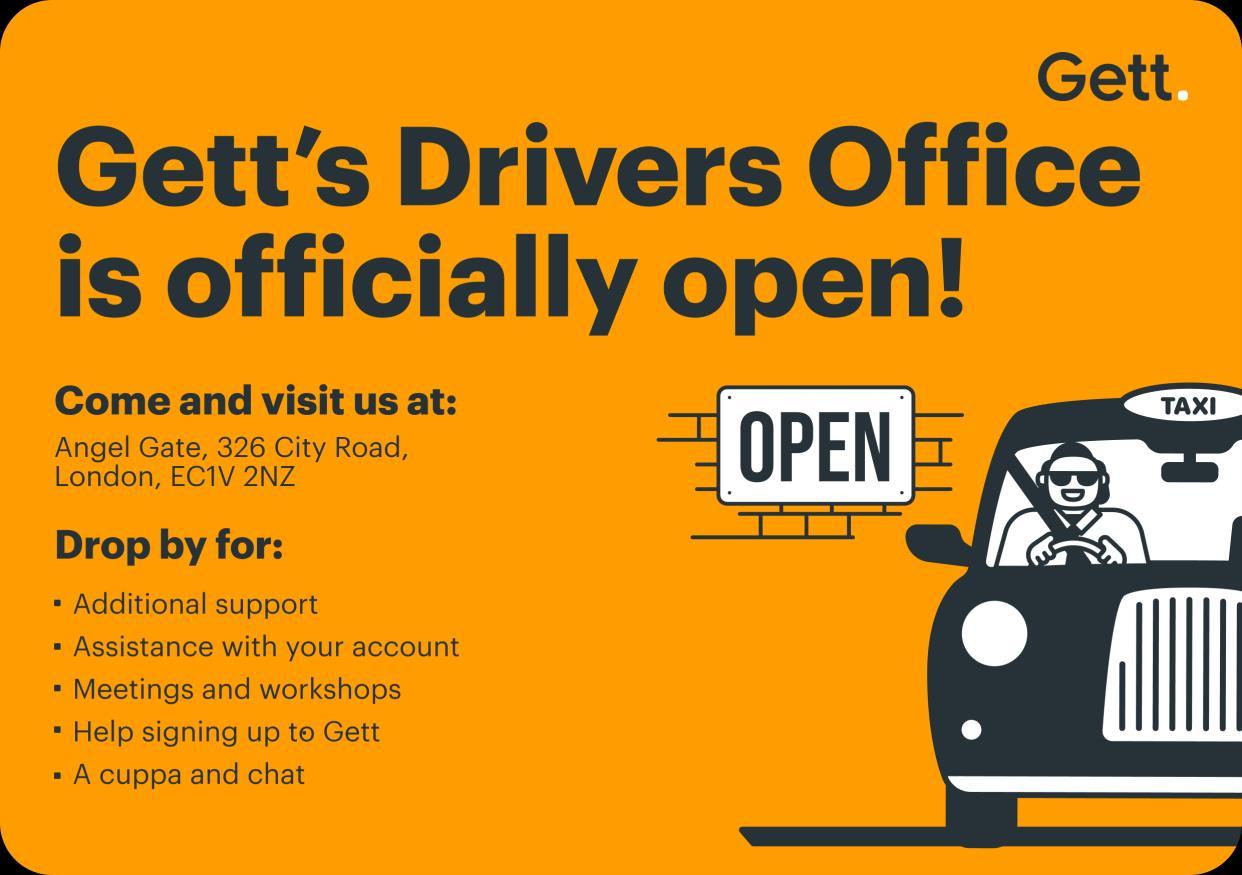

inspections, and operational standards. This gives them an advantage over ride-hailing platforms, where there have been ongoing worries about inconsistent driver vetting and safety protocols.
The taxi industry could better promote its strong safety record, emphasising the rigorous checks that drivers undergo and the professionalism of licensed taxi operators. This message could resonate particularly well with female Gen Z travellers, many of whom may have had negative experiences or safety concerns with ride-hailing services.
Generation Z is largely cashaverse, preferring the convenience of digital and contactless payments. While most traditional taxis now accept card payments, they need to go further to meet the expectations of younger customers. Offering a wide range of payment options, including mobile wallets like Apple Pay, Google Pay, and PayPal, as well as in-app payments, is essential.
Cashless payments not only make the customer experience smoother but also reduce friction in the booking process. The ability to pay through an app or instantly via contactless methods aligns with Gen Z’s demand for a hassle-free, modern transport experience.



Ride-hailing services have successfully captured a significant portion of the Gen Z market by offering promotions, referral codes, and loyalty schemes. These incentives provide value for budgetconscious travellers, who are always on the lookout for ways to reduce costs.
Traditional taxis could introduce similar schemes, offering discounts on frequent journeys, special rates for students, or promotional offers during offpeak hours. By rewarding loyalty and offering competitive pricing, taxis can compete more effectively with ride-hailing platforms on price, without sacrificing service quality.
To truly capture the attention of Generation Z, the traditional taxi industry needs to rethink its marketing strategy. Ride-hailing platforms have heavily invested in digital marketing, engaging with younger audiences on social media platforms like Instagram, TikTok, and YouTube. Taxi firms need to do the same.
Developing targeted campaigns that highlight the benefits of traditional taxis such as safety,
professionalism, and sustainability could help shift the perception of the industry among younger audiences. Influencer partnerships, social media campaigns, and online advertisements that speak directly to Gen Z’s concerns could raise the profile of taxis and reframe them as a modern, reliable, and eco-friendly alternative to ride-hailing apps.
For traditional taxis to win a larger share of the Generation Z market, they must modernise marketing and booking features while leveraging their existing strengths. Digital integration, pricing transparency, and embracing sustainable practices are essential steps to staying relevant in an increasingly competitive transport landscape.
While the battle for Gen Z’s travel preferences is still largely being won by ride-hailing platforms, history has shown that the younger generation have always arrived on the taxi market further down the line. However, with the right approach, taxis can also position themselves as a credible, modern choice for a new generation of passengers and take a piece of the Gen Z pie.
“The ability to pay through an app or instantly via contactless methods aligns with Gen Z’s demand for a hassle-free, modern transport experience.”
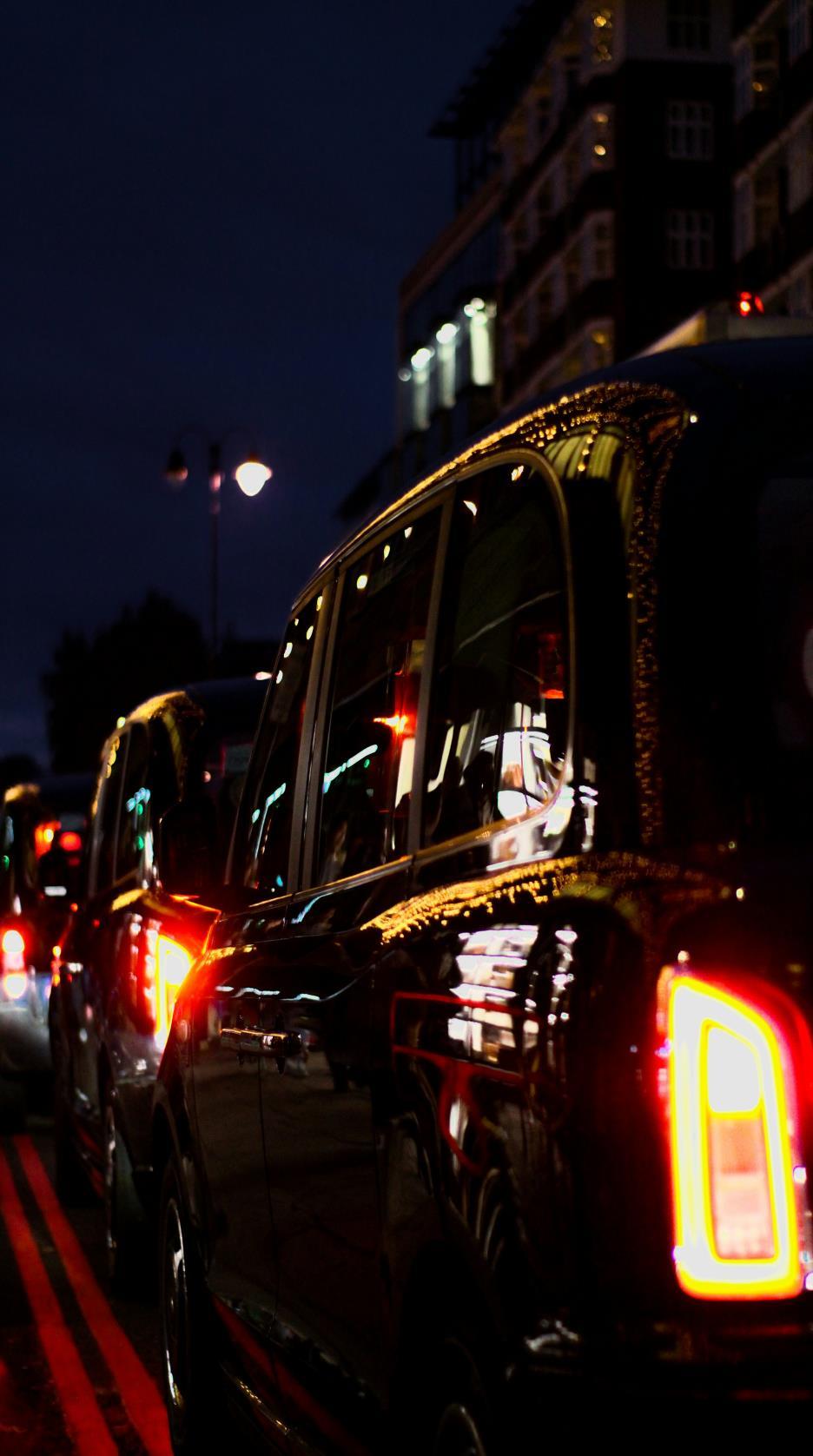




The Department for Transport's report on non-visible impairments has highlighted challenges faced by people with hidden disabilities when using various transport modes, including taxis. For taxi drivers and operators, this offers a clear opportunity to adapt services to better meet the needs of this often-overlooked group of passengers.
For those with impairments like autism, anxiety, or memory issues, taxis are often a preferred mode of transport due to the flexibility and control they provide. Many passengers reported feeling safer in a taxi compared to crowded buses or trains. However, barriers still exist, particularly around communication.
One key issue is booking. Many passengers with non-visible disabilities struggle with the anxiety of
phone calls, especially when needing to provide or understand information quickly. Taxi companies could ease this anxiety by expanding online booking systems or apps, which allow passengers to book without direct verbal interaction. In addition, providing a clear, visual interface for booking, complete with easy options for specifying accessibility needs, could encourage greater taxi use among this group.
Passengers also appreciate consistency. They often return to the same drivers or firms when they feel comfortable, suggesting there is value in cultivating familiarity. Drivers who understand a passenger's specific needs can make the journey smoother. One recommendation is to create a system where passengers can request specific drivers with whom they’ve had positive


experiences. This could foster trust and help more passengers feel comfortable travelling alone.
The research highlighted that many passengers with hidden disabilities value predictability. Some reported being anxious about taxi arrival times. Expanding the use of tracking apps that provide real-time updates on the vehicle's location could address this issue. Such features are already commonplace in ride-hailing apps, but traditional taxi firms could benefit significantly from adopting these features to alleviate passenger stress.
Training drivers in recognising and understanding non-visible impairments could also be beneficial. Simple actions, like understanding that a passenger may struggle to communicate or may need extra time to enter or leave the vehicle, can make a significant difference. An awareness of common non-visible conditions, and how to assist subtly and sensitively, would help drivers better serve these customers.
Finally, affordability remains a challenge. Many participants said that while taxis are often their preferred choice, they can be costprohibitive for regular journeys.
Collaborations with local councils or the introduction of subsidised schemes for those with disabilities could provide some relief, making taxis a more viable daily option.
The report makes it clear: taxis are a lifeline for many with non-visible disabilities. By adapting booking systems, promoting driver familiarity, offering real-time tracking, and ensuring drivers are trained to meet specific needs, the taxi industry could enhance accessibility significantly for this important group of passengers.



Taxi services are seen as a solution to reduce the pressure on bus routes in sparsely populated areas. With decreasing passenger numbers and limited funding, rural bus services are struggling to stay viable, creating significant mobility challenges for communities.
Lord Stevenson of Balmacara recently questioned the role that rural taxis might play in addressing this issue. He asked whether they could help alleviate the burden on under-resourced bus routes, especially in low-population areas, and contribute to improved environmental outcomes.
Responding, Lord Hendy of Richmond Hill, the Transport Minister, highlighted that taxi and private hire vehicle policy falls under devolved administration across the UK. He acknowledged that the flexibility offered by taxis and private hire vehicles could indeed fill transport gaps, particularly in rural communities, a point supported by the Department for Transport's guidance to local licensing authorities in England.
This topic is also being explored in practice through the Rural Mobility Fund's demand responsive transport (DRT) minibus pilot scheme. The initiative is being tested in 14 local authorities, looking into
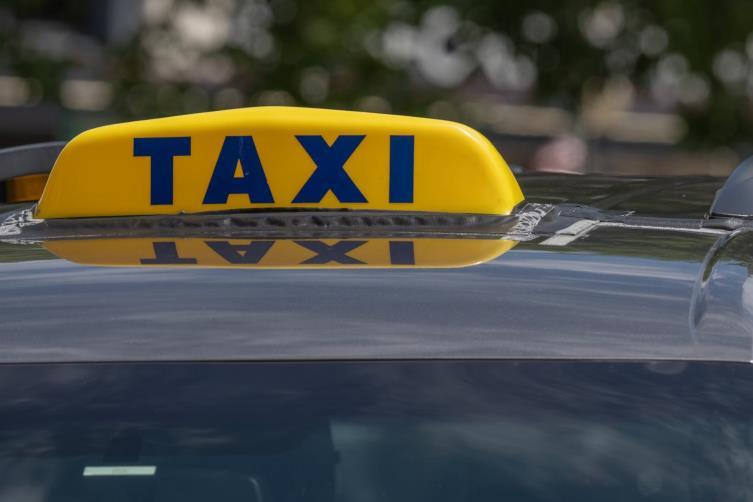
whether DRT services can be a feasible transport solution in rural and suburban regions, either as standalone services or alongside other forms of public transport. A comprehensive evaluation process, which includes both impact and procedural assessments, is underway, with the final report expected next year.
Lord Hendy of Richmond Hill, Transport Minister, replied: “Taxi and private hire vehicle policy is a devolved matter in all UK nations. The role the trade can play in providing flexible transport services, especially in rural areas, is recognised in Department for Transport guidance issued to licensing authorities in England.
“The Rural Mobility Fund demand responsive transport (DRT) minibus pilot, currently underway in 14 different local authorities, is exploring whether DRT can provide a solution in rural and suburban areas, either alone or in conjunction with other services. A comprehensive monitoring and evaluation process is in place, consisting of a process evaluation and an impact evaluation. The final process evaluation report is due next year.”


Aworrying new trend is emerging among young drivers in the UK, with nearly a third admitting to taking pictures or filming video footage while at the wheel. A recent study of 1,000 motorists aged 18 to 26, commissioned by road safety charity IAM RoadSmart, reveals that risky driving behaviour among this age group is alarmingly common, often spurred on by the desire to share content on social media.
The findings show that 31 per cent of young drivers have either filmed or photographed themselves while driving, with more than half of these then uploading the footage online. Equally concerning, one in six have sent text messages while driving a behaviour that significantly raises the likelihood of accidents. Beyond distractions, 41 per cent have driven while tired, and one in 20 admitted to
driving under the influence of drugs or alcohol.
Though eating behind the wheel isn’t illegal, nearly half of those surveyed admitted to doing so. This raises further safety concerns, as police have the authority to charge motorists with careless driving if they deem the driver not in full control. Such an offence can lead to a £100 fine and three penalty points.
Despite these behaviours, many young drivers still perceive themselves as following the rules. In fact, nine in 10 respondents said they believed they were consistently law-abiding. However, one in six admitted to driving at speeds exceeding 90 miles per hour. Motorists caught at such speeds face serious penalties, from receiving four to six points to potentially losing their licence something particularly risky for new drivers, who lose their licence automatically after
accumulating six points within two years of passing their test.
Department for Transport data shows that young drivers are particularly vulnerable on the roads. One in five new drivers will be involved in a crash within a year of passing their test, and crashes involving young drivers resulted in nearly 5,000 deaths or serious injuries in 2022.
There is, however, a positive note. A substantial 85 per cent of young drivers said they would consider taking an advanced driving course, with 72 per cent also expressing interest in testing their driving skills on a racetrack. In response to this, IAM RoadSmart recently hosted its first Young Driver Skills Day at Thruxton circuit. The event provided an opportunity for young drivers to learn advanced skills, from correcting skids to handling performance vehicles in a controlled environment.


Greater Manchester is set to submit an updated Clean Air Plan to the Government following encouraging improvements in air quality across the region. The preferred approach continues to avoid charging any vehicles using the city’s roads, while promoting investment in cleaner buses and supporting taxi drivers in upgrading their vehicles.
New projections show the plan will achieve the legal air quality targets by 2026, slightly delayed from the 2025 target set in the 2023 submission. An alternative plan proposing a charging Clean Air Zone for Manchester and Salford has been ruled out, as it would fail to meet the deadline.
A key component of the updated plan focuses on cleaner buses. Recent figures show the introduction of greener vehicles is already making a difference, with air pollution levels in 2023 lower than those recorded in 2022 and significantly down on pre-pandemic levels in 2019. Nitrogen dioxide levels, once high at 129 locations, now exceed limits in just 64 sites.
The introduction of Zero Emission Buses (ZEBs) under the Bee Network and the transition to franchised bus services have driven much of the improvement. The proportion of electric buses in franchised areas has grown from under 1% to more than 10%, with a target for a third of the fleet to be electric by 2027 and an all-electric fleet by 2030.
Alongside bus electrification, the revised plan also provides for £30.5m to help hackney carriage and private hire drivers switch to cleaner vehicles, as well as £5m for traffic management measures aimed at reducing emissions on Regent Road and Quay Street.
The updated Clean Air Plan was published on 18 September 2024 and will be submitted for government approval. The final decision on the plan rests with the Government’s Joint Air Quality Unit.
Leader of Bury Council and Clean Air lead for Greater Manchester, Cllr Eamonn O’Brien, said:
“Poor air quality affects us all and particularly the most vulnerable among us – the young, old and those with health conditions. We have a longstanding commitment to cleaning up our air and Greater Manchester has carried out a tremendous amount of work to get us to a place where we are seeing air quality improvements.
“The latest air quality monitoring data shows a really encouraging trend and indicates that the steps we’ve already taken to invest in cleaner buses through the Bee Network are making real inroads to cleaning up the air we all breathe. And we’ve done this without the hardship to residents and businesses that a charging Clean Air Zone could cause.”



The Mayor of London, Sadiq Khan, has announced that a new Taxi and Private Hire Action Plan will be unveiled ‘early next year’.
This follows increasing concerns over the future of London's black taxis and the wider private hire sector.
In a written question, London Assembly Member Hina Bokhari sought clarity on the Mayor’s stance regarding the 40-year low in the number of licensed taxis operating in the capital. She also asked whether the new action plan would address this decline.
In response, Khan confirmed that Transport for London (TfL) is preparing a revised plan for the industry. This plan, he explained, has been shaped by consultations with taxi and private hire representatives, as well as other stakeholders, to pinpoint key challenges.
The decision to refresh the 2016 plan follows a push from former Liberal Democrat Assembly Member Caroline Pidgeon last
winter. She urged the Mayor to address the out-ofdate framework and tackle the issues affecting the taxi industry’s long-term sustainability.
Sadiq Khan, Mayor of London, said: “Transport for London is in the process of producing a refreshed Taxi and Private Hire Action Plan. This has involved a number of engagement sessions with taxi and private hire representatives and wider stakeholder groups to understand key concerns and issues within the taxi and private hire industries.
“The new Action Plan will be published early next year.”


A recent call for more taxis at Heathrow Airport has reignited frustrations over the restrictive access system in place for cabbies.
A social media account associated with the Heathrow Taxi Feeder Park posted an urgent request, stating they were "low on taxis" due to high demand, urging more drivers to step in.
However, many taxi drivers were unable to respond, citing the ongoing issue of not being able to obtain the necessary 'tag' device required to access the airport’s taxi ranks.
One frustrated driver shared their experience: “I dropped off at Terminal 3 when taxis were needed,
but I still can’t get a tag. I had to drive past an empty rank and a queue full of passengers.” The driver went on to say they had been waiting three years for a tag, calling the system a "closed shop".
The frustration was echoed by other drivers, with some suggesting a system similar to London’s City Airport, where drivers pay a small fee to join the rank. “It’s your passengers that suffer during busy times,” one driver noted, highlighting the impact on travellers.
Heathrow, the largest taxi hub in London, can hold up to 500 cabs at once. Yet, since 2019, the airport has implemented a 'one in, one out' policy for new drivers seeking access tags. This has left many in the industry stuck on long waiting lists, relying on existing tag holders to relinquish their permits before gaining access.
With the number of licensed cab drivers dropping from over 20,000 in 2019 to just 15,000 today, some are questioning whether the system needs reform.
diesel taxis, such as the TX4, meet Euro 6 emissions standards.
For many taxi drivers, retrofitting could be an attractive option. By upgrading their existing vehicles, drivers can avoid the expense of purchasing a new taxi while still adhering to tighter emissions regulations. This approach not only helps drivers extend the lifespan of their black cabs but also allows them to continue working without the financial strain of investing in new vehicles.
Transport for London (TfL) is now inspecting the TX4

This development follows successful tests at Millbrook Proving Ground earlier this year. It represents a crucial step towards helping older
The initiative is expected to appeal to drivers looking for a more affordable route to maintaining compliance and extending their working life in an increasingly regulated market.
A HJS Emissions Technology spokesperson said on social media: “TX4 Being inspected by TfL today! We hope to be commencing the final stage of 5,000 miles durability testing shortly... Watch this space…”

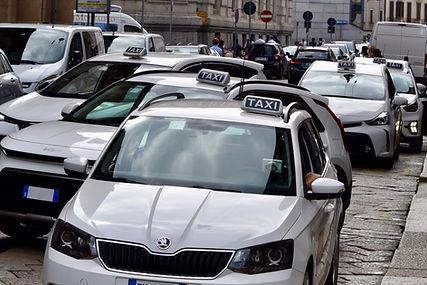
A new report by UITP, the internationally recognised association for public transport, has provided a comprehensive overview of the global state of taxi and ride-hailing services.
"The Global Taxi and Ride-Hailing Figures 2024" offers valuable data on the industry's operations, workforce, and its ongoing efforts to decarbonise and embrace digitalisation.
Taxi and private hire vehicle services are increasingly seen as essential components of public transport systems, helping to extend the reach of traditional networks, particularly in areas with lower population density. Shorter, more affordable trips can bridge the gap between public transport hubs and outlying urban areas, making cities more accessible.
The report examines trends from 2022 and 2023, comparing data from selected cities across the world. Key areas of focus include fleet size,
SECURES NEW TFL LONDON OPERATOR’S LICENCE UNTIL MARCH 2027

Uber has been granted a new 30-month private hire operator’s licence in London by Transport for London (TfL), extending its operations until March 2027.
The decision reinforces Uber’s position in its largest UK market, where over 108,000 private hire drivers are currently licensed for an array of different operators that include giants like Uber, Bolt
Addison Lee and FREENOW.
Details of the new licence have not been disclosed by TfL yet, but the renewal highlights Uber's continued influence in the capital.
Since 2021, the company has seen a significant 70% increase in drivers throughout the UK, with over 100,000 now using the platform.
passenger numbers, fuel types, and the regulatory environment around fares. The findings were gathered from public authorities between March and May 2024, shedding light on how these services compare locally and globally.
The study also explores the sector's workforce, highlighting the share of self-employed drivers and other demographic insights. As decarbonisation becomes a central goal, the report provides a look into how fleets are transitioning to cleaner vehicles, offering a glimpse into the future of urban mobility.

UUber has unveiled a series of new safety features aimed at enhancing the experience for its drivers. CEO Dara Khosrowshahi announced these updates, which are designed to offer drivers more control, security, and ease of use while driving with the platform.
One of the most significant changes is the nationwide rollout of enhanced rider verification.
an incident. This feature is designed to offer drivers an additional layer of protection and make resolving disputes easier.
Additional technology updates include:
Trip navigation on Tesla displays: Uber drivers with Tesla vehicles can now integrate their car's display with the Uber app, allowing for seamless turn-bys screen. This aims to improve the driving experience and reduce

using their smartphone's front facing camera, without needing to invest in a dashcam. The recordings are encrypted and stored on the driver’s device, ensuring privacy, as only the driver can choose to submit the footage for review in case of
For iOS users, drivers can now use Siri to customise activated shortcuts in the Uber app. These include actions like calling a rider or going online, all without needing to touch their
Drivers can now enable a PIN system to verify that they are picking up the correct rider. Riders must provide a PIN to the driver before the trip can start, adding an extra layer of security to
Uber has addressed the confusion that can occur when picking up a guest who is different from the person who booked the ride. Now, drivers will be able to communicate directly with guest riders via phone or in-app messaging, even if the guest doesn’t have the Uber app.


FREENOW, the multi-mobility platform centred around taxi services, has reached a significant milestone by achieving financial break-even.
This success comes as the company shifts its strategic focus to its core taxi business, resulting in a 13% year-on-year revenue increase by August 2024. CEO Thomas Zimmermann announced the achievement at the Bits & Pretzels 2024 event in Munich.
The app, operational in nine European countries, including the UK, France, and Germany, has bolstered its urban mobility services by focusing on reliability and safety in the taxi sector.
FREENOW also continues to offer other transport options like e-bikes, e-scooters, and car-sharing, ensuring it remains a versatile choice in the crowded mobility market.
FREENOW's emphasis on taxis aims to cement its leadership in the sector across more than 150 European cities. By partnering with over 150,000
drivers and collaborating closely with local taxi operators, the company maintains strong ties with the communities it serves, supporting local economies and enhancing urban transport options.
Germany, one of FREENOW's key markets, has seen notable growth in demand for taxis, particularly through the introduction of fixedprice fares in Munich and Berlin. In Berlin alone, taxi rides facilitated by FREENOW have increased by over 50% year-on-year. With over 20,000 taxis now available across Germany, and driver numbers up by 10%, the platform continues to expand its reach into cities such as Nuremberg, Freiburg, and Heidelberg.
In other core markets like Ireland, Spain, the UK, and Greece, FREENOW has maintained its position as the top taxi app. The platform's growth has included expanding fleets, increasing driver availability, and launching new services. In London, 70% of rides booked through FREENOW

now use zero-emission capable vehicles, reflecting the platform's commitment to supporting the electric transition of the city's iconic black cabs.
Further south, FREENOW has expanded to new Spanish cities and introduced fixed-price options in Madrid and Barcelona. In Greece, the company is also targeting growth in the tourism sector, expanding to Crete in addition to its presence in Athens and Thessaloniki.
With over 15 years of history in the taxi industry, FREENOW is well-placed to drive digital transformation within the sector. The company’s relationships with regulators and unions, coupled with a strategic focus on technology, position it to lead this evolution. With around 60% of ride-hailing still happening offline across Europe, FREENOW sees significant potential for growth as it looks to modernise the taxi industry and harness opportunities in both the online and traditional markets.
Thomas Zimmermann, CEO of FREENOW, said:
“We are convinced that taxis are vital to every city’s mobility ecosystem. Our commitment to working with local taxi drivers and operators is the right approach for sustainable growth and success on both sides. Achieving break-even is a first substantial step and proves the efficacy of our taxi-first strategy. We are dedicated to our vision, prioritising growth and sustained profitability in Europe.
“Our near-term strategy for FREENOW is to strengthen our position as the go-to taxi app in our leading markets, while aiming to achieve this status in all our operating regions and expand into more European cities. As a taxi-first business, we will also continue the modernisation of the taxi sector, by building partnerships with offline dispatchers and offering our online solutions to digitalise their business. The offline taxi market is huge and FREENOW, with its historic taxi background, is well positioned to capture its still untapped potential.”

“Our commitment to working with local taxi drivers and operators is the right approach for sustainable growth and success on both sides.”


has revealed that nearly a quarter (24%) of private hire drivers are binging in more than £4,000 per month in revenue through ride-hailing apps. The data also shows that 88% of drivers operate across multiple platforms like Uber, FREENOW and Veezu to maximise their earnings.
Bolt has now launched its 'Be Your Own Boss' campaign to highlight the entrepreneurial opportunities in the ride-hailing sector. With over a third (34%) of drivers identifying themselves as entrepreneurs, and nearly half (49%) aspiring to become business owners, ride-hailing is being viewed as a stepping stone to independence.

Operations at Bolt, said: “Private hire driving is one of the easiest ways to become your own boss. Ride-hailing platforms enable drivers to connect with a ready-made customer base and start earning from day one. This has encouraged more people than ever to tap into the growing ridehailing market, and make the most of the uncapped earning potential and flexibility that independent contracting offers them.”
confirmed the renewal of its sponsorship deal with New Panteg RFC, a Pontypool-based rugby club that plays a key role in Welsh rugby development. New Panteg RFC is part of the Welsh Rugby Union and acts as a feeder club for the Newport Gwent Dragons.
The renewed partnership sees Veezu providing £1,000 to the club, which will go towards purchasing new postprotectors. This is part of the company’s continued investment in grassroots sports across Wales, demonstrating its commitment to supporting local communities.
Nathan Bowles, Chief Executive of Veezu, said: “We’re proud to continue our sponsorship of New Panteg RFC as part of our Funded by Veezu initiative. Supporting grassroots sports is central to our commitment to local communities, and we’re excited to help the club with the donation of new postprotectors this season. We look forward to seeing the team thrive both on and off the field, and we’re excited to be part of their journey.”

A 71-year-old Stratfordupon-Avon driver has had his Dual Driver’s badge revoked after a hearing by Stratford-on-Avon District Council’s Licensing Panel on 4 September 2024.
The driver had previously been warned about his conduct and breaches of licence conditions.
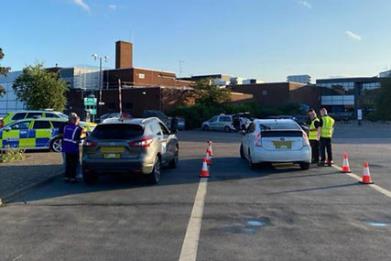
The Licensing Panel reviewed a series of incidents reported by the Licensing Officer, concluding that his driving failed to meet the standards required by the council. This raised serious concerns about his ability to continue holding a Dual Hackney Carriage and Private Hire Driver's Licence.
The Panel made the unanimous decision to revoke the licence immediately, citing public safety as the primary reason.
The driver was entitled to appeal the decision within 21 days, but he chose not to. He is no longer a licensed driver with Stratford-onAvon District Council.
Cllr Lorraine Grocott, Portfolio Holder for Environmental and Neighbourhood Services, said: "Public safety is of vital importance when it comes to considering whether a driver is fit and proper to hold a licence. In protecting public safety, we expect our drivers to maintain the high standard that is expected of them and their licensed vehicles when carrying passengers, especially those that are vulnerable or elderly in our community.
“The standard that Stratford on Avon District Council expects of its licensed drivers fell below that which is expected from this driver."
The Hinckley Area Taxi Association (HATA) has officially requested an increase in fares for hackney carriages. The move is in response to rising operational costs, including fuel, vehicle maintenance, and insurance, which the trade body claims are making it increasingly difficult for drivers to sustain their services.
The matter is further complicated with HATA describing how the region is losing drivers to ridehail giants Uber who are ‘flooding’ the area. It is hoped that a more completive tariff will help retain drivers.
The last fare review by Hinckley and Bosworth Borough Council was approved in 2022. However, with current fares placing the area 266th out of 364 authorities across the UK, the Association is pushing for an uplift to bring tariffs in line with other districts.
The proposal sets out two potential fare structures. In the first, the basic Tariff 1 fare would rise from £2.80 to £3.20, while the second proposal suggests a slightly higher increase to £3.40.

A PHV driver from Oldham has been banned from driving and had his licence revoked after continuing to work under a suspended licence.
Ibrar Hussain, 32, had his private hire licence suspended by Oldham Council after his criminal record certificate expired. Despite this, Hussain continued to drive, invalidating his insurance and committing what was seen as a serious offence.
Hussain failed to attend his court hearing at Tameside Magistrates' Court on 19 September, where he was found guilty in his absence of driving without insurance and a valid private hire licence. As a result, he received a two-year driving ban.
The court also imposed a fine, along with costs and a surcharge, totalling £4,671. Following the conviction, Oldham Council revoked his licence with immediate effect.
Councillor Elaine Taylor, Deputy Leader of Oldham Council and the cabinet member responsible for Licensing, said: “In general, taxi standards in Oldham are very good.
“However, where breaches do occur, the penalty imposed in this case by the court shows that this sort of behaviour will be taken seriously, and the consequences can be severe.”

A Worksop-based taxi firm has made strides in tackling the district’s driver shortage by hosting a streamlined pre -licensing event, with support from Bassetlaw District Council.
The event, organised by taxi operator 6Five2, aimed to speed up the application process for prospective drivers, ensuring that all necessary pre-licensing checks were completed in a single session.
Attendees had the opportunity to conduct ID checks, book DBS appointments, complete safeguarding tests, and
undergo medical and driving assessments.
Bassetlaw District Council’s Licensing team also attended to provide guidance, while applicants were able to take the required Knowledge Test. The event saw an impressive 89% pass rate on the day.
As a result, 29 new drivers are now in the final stages of obtaining their licences, set to bolster transport options in the district in the coming weeks.
Following the success of this initiative, further fast-track events are being considered to help ease the driver shortfall in the area.



B-standing policy requiring private hire vehicles (PHVs) to display illuminated roof signs, which has been in place since 2004.
This move comes in response to changing technology and requests from representatives of the private hire trade, who argue that roof signs are now redundant.
For years, roof signs have been viewed as a critical public safety measure, helping passengers easily identify licensed vehicles. However, with most bookings now made via apps, where customers receive vehicle and driver details in advance, some see these signs as less relevant.
The Department for Transport issued revised guidance in November 2023, recommending the prohibition of roof signs on PHVs to avoid confusion with taxis, which can be hired on the street. The
taxis and PHVs would reduce illegal plying for hire and potential conflicts when drivers refuse on-thespot fare requests.
Locally, Bedford is one of the few authorities still mandating roof signs, as neighbouring councils have dropped this requirement. Uber has already indicated that this policy might hinder their potential expansion in the area.
While the roof signs are relatively inexpensive at around £100, trade representatives believe the cost, along with technological advancements, makes their use unnecessary. The Council now faces a choice: maintain the current policy, remove the requirement, or consult with the public and industry before deciding.
A decision is expected in due course.

Buckinghamshire Council has successfully defended its decision to refuse a hackney carriage and private hire licence for a driver whose record fell short of the required standards.
Mr Asghar saw his application for a taxi driver licence refused following an incident that led to his driving licence being endorsed with seven penalty points. The penalty followed a collision with a motorbike in November 2020, which resulted in a charge of driving without due care and attention.
In making its decision, Buckinghamshire Council considered not only the recent offence but also Mr Asghar's driving history, which included a previous revocation of his taxi licence by Wycombe District Council in 2018 due to concerns about his driving standards.

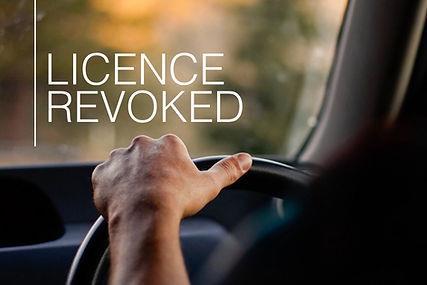
Mr Asghar appealed against the refusal, taking the matter to Wycombe Magistrates' Court on 13 September 2024. However, the Magistrates upheld Buckinghamshire Council's original decision, agreeing that the refusal was in line with council policy.
Under Buckinghamshire’s Hackney Carriage and Private Hire Licensing Policy, applicants with a major traffic offence that has resulted in injury or property damage are ineligible for a licence for at least seven years. The court’s decision reflected this policy, dismissing Mr Asghar’s appeal.
In addition to losing the appeal, Mr Asghar was ordered to pay £2,451.92 to cover Buckinghamshire Council’s legal costs.
A recent joint taxi enforcement operation by Thames Valley Police Roads Policing Unit and a local authority in South Oxfordshire has raised concerns over the licensing compliance of taxi drivers in the area.
During the operation, Abingdon C Shift officers stopped multiple vehicles to assess adherence to safety and licensing regulations. Initial findings
show that 60% of the taxis inspected failed to meet licensing standards. The most common issues related to basic safety offences.
The enforcement team issued five tickets for infractions including seat belt and light-related offences. In addition, enforcement officers handed out a total of 150 penalty points across various breaches.

A recent meeting of the Pendle Borough Council Taxi Licensing Committee at Nelson Town Hall has brought an unusual proposal to the table: the introduction of licensed horse-drawn carriages to the town’s Hackney carriage fleet.
The committee, led by Councillor Newman, gathered on 12 August 2024 to discuss the feasibility and framework for such a service.
Control and Regulatory Services, which proposed an amendment to the town's taxi licensing policy. The current limit of 71 Hackney carriage licences would need to be extended to accommodate four new licences solely for non-motorised, horsedrawn vehicles.
If adopted, the council would introduce specific conditions for these horse-drawn carriages. This would include a table of fares, which was also presented to the committee. The fare structure, designed to reflect the unique nature of the service, would be advertised to the public for feedback under the Local Government (Miscellaneous Provisions) Act 1976.
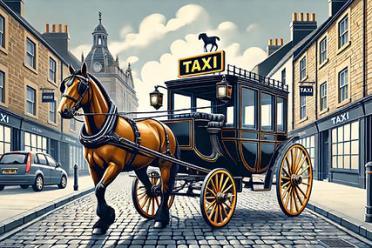
The committee reviewed a report submitted by the Assistant Director of Planning, Building
Taxi fares in Dundee could see an increase of 12.72% from 1 December if plans are approved by the city’s licensing committee.
The proposed hike comes as part of the council's annual review of pricing, just in time for the busy Christmas period.
The committee recommended that the Council amend the taxi policy to issue these new licences, potentially bringing a touch of tradition back to Nelson’s streets. The decision now moves to the Executive for final approval.
The new fare structure would impact all tariffs, covering daytime, weekday evenings, weekend evenings, and festive periods. If approved, the revised rates would mean higher costs for passengers to help cover the sharp increase in costs paid out by cabbies.
For daytime rides, the base fare (Tariff 1) is set to rise from £3.75 to £4.20, with an increase in the cost per 1/10th of a mile from 19p to 22p.
Evening weekday journeys (Tariff 2) could jump from £4.09 to £4.62, with a similar increase in the cost per mile increment from 21p to 24p.
evening fares (Tariff 3) would see a rise from £4.43 to £5.04, with each additional 1/10th of a mile increasing from 23p to 26p.
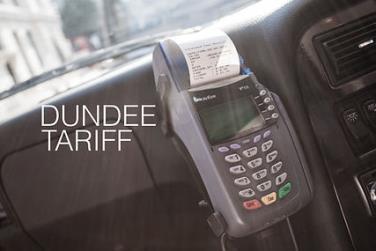
For the festive period (Tariff 4), the base fare would rise from £5.11 to £5.58, with each 1/10th of a mile rising from 26p to 31p.

City of Wolverhampton Council's Regulatory Committee is set to consider a proposal allowing panic switch-activated audio recordings in taxis and private hire.
The proposal follows a series of violent incidents against drivers, including the murders of two Wolverhampton-licensed drivers in 2022. The current policy, introduced in 2021, prohibits all audio recording in taxis to protect passenger privacy. However, the increasing safety concerns have led to a review of this position.
The council’s revised plan would permit audio recording only in emergencies, where a driver activates a panic button. This limited use of audio aims to provide crucial evidence in incidents such as assaults or robberies, without compromising passenger privacy on a continuous basis.
Wolverhampton Council's stance mirrors that of other authorities, including Rotherham and Southampton, which permit similar systems.
The proposed system is designed to enhance driver safety, and there have been no complaints
or issues during a pilot phase in which a Wolverhampton taxi installed such a system. Signage will inform passengers of the presence of CCTV and the possibility of audio recording, which will only be triggered by the driver during an emergency. Data protection measures will be in place, ensuring compliance with UK GDPR and other legal obligations.
A six-week public consultation is planned before the council makes its final decision. If approved, taxi drivers would be able to install the system without additional costs, but they must provide certification of installation and ensure compliance with licensing regulations.



Wolverhampton’s taxi compliance officers, alongside West Midlands Police and a local councillor, conducted unannounced inspections of taxis and private hire vehicles.
The operation, intended to ensure that all vehicles remain fit for purpose, saw licensing officials stop and assess the condition and legality of the cars in use.
Images released by officials show the joint effort as compliance officers and police reviewed the vehicles, scrutinising documentation and overall safety standards. The operation resulted in at least one vehicle being suspended from service, deemed unfit for private hire use.
A City of Wolverhampton Public Protection spokesperson said: “Wolverhampton Taxi Compliance working with West Midland Police and joined by local councillor in Wolverhampton spot checking taxis and private hire vehicle ensuring fit for purpose.”
‘DANGEROUS
FIVE TAXI AND PRIVATE HIRE LICENSING SUSPENSIONS DISHED OUT FOLLOWING OPERATION

A recent taxi and private hire licensing operation conducted in Derby has led to the suspension of five licences, according to the Derbyshire Roads Policing Unit (RPU).
The initiative, aimed at ensuring public safety, saw numerous licensed vehicles inspected, with the majority found to be in compliance with regulations.
In photos shared online, three of the vehicles included a distinctive yellow taxi with its sliding door open, a silver Toyota Prius private hire vehicle and a grey Mercedes private hire.
Five vehicles were found to have ‘dangerous defects’. As a result, the affected cabs
had their licences suspended and plates removed. In cases where necessary, prohibition notices were issued to prevent the vehicles from operating further until the issues were rectified.
A Derbyshire Roads Policing Unit (RPU) Bikers spokesperson said on social media: “Taxi licensing operation in Derby.
Numerous taxis checked and good to see the majority in good order, however 5 taxis have had their licence suspended and plates removed following dangerous defects being identified.
”Prohibition issued where necessary.”

Avon and Somerset Police ‘Taxi Cop’ intercepted a taxi carrying passengers in the Bristol area, driven by an unlicensed driver.
The discovery was made on Colliters Way by PC Quinton, the industry’s only specialist taxi and private hire vehicle police officer.
The driver was found operating the vehicle without holding the necessary licence, which automatically invalidated any insurance policy attached to the taxi.
By law, drivers of licensed taxis must possess the appropriate licence to ensure passengers are transported in a safe, regulated manner.
Operating without a valid taxi driver’s licence is an
the invalidation of insurance, leaving passengers vulnerable in the event of an accident.
Due to the lack of insurance, PC Quinton immediately had the vehicle towed away. The driver, along with the operator, will now face further enforcement action for the breach of regulations.
PC Quinton, Taxi Cop Avon and Somerset Police, said: “At Colliters Way earlier I found this taxi with passengers on board being driven by an unlicensed driver.
“This means he was uninsured so I've had it towed away. Further enforcement action to be taken against driver and operator.”




















